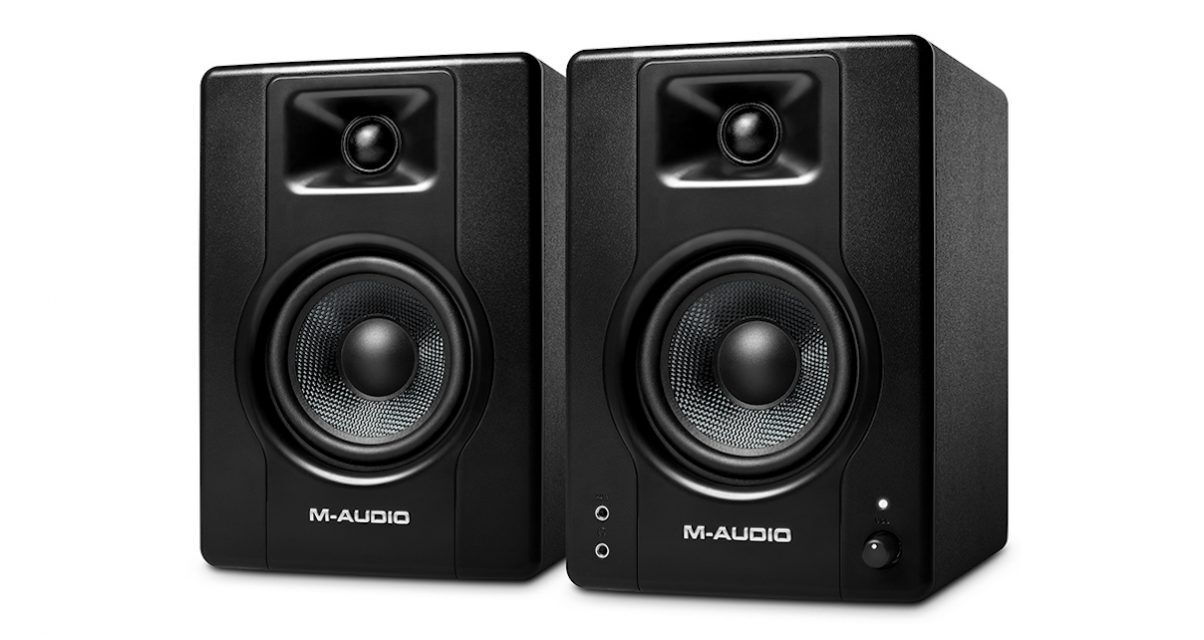The Lowdown
For the money, they’re a good little pair of speakers, and a huge step up from cheap computer speakers, with good enough bass, and clear treble. Will work fine for small DJ practice rooms, for podcasting, livestreaming, and beat making. As they’re aimed at the general user, Bluetooth would have been nice.
Video Review
First Impressions / Setting up
The speakers are basically black rectangular boxes, but with enough rounded corners to feel “finished”. They have 4.5″ woofers, and 1″ tweeters, and are sold as 120W speakers, but are really 25W RMS – which is nonetheless plenty loud enough for your practice room.
They are made from MDF with a plastic front, and a screwed-on plastic back panel, which has a bass reflex port.
They’re lightweight, one being considerably lighter than the other because it is a secondary speaker to the other, the primary, which contains all the electronics, the amplifier, the controls and so on. That makes them different from the bigger M-Audio BX5-D3, which is a self-contained model.
A mono 1/8″ to 1/8″ jack cable is provided to link the two. It’s good that this is a “standard” cable – some speakers of this type use a proprietary cable, which is a pain if it breaks or you lose it. It is, however, a pretty low quality cable, and only 6′ long – if you want longer or experience issues, it would be worth replacing.
The box also contains a stereo 1/8″ to 1/8″ cable jack cable (for plugging a music source into the usefully-positioned Aux socket on the front of the primary speaker) , and an RCA cable-to-1/8″ cable. Both are budget, too.
Learn what gear you need for DJing: The Complete DJ Course
On the front of the primary speaker there is an 1/8″ headphone sockets, and a master volume control, that also has a satisfying “click” to turn the pair on and off.
Around the back of the primary speaker are more sockets: The aforementioned RCA inputs, a pair of balanced 1/4″ jack inputs, the output socket for wiring to the secondary speaker, and a power socket for the supplied power cable.
The power transformer is built-in to the speaker, which is nice – no power brick like some speakers of this type.
Some nice additions around the back are high and low EQs (they are more to “tweak” the sound, once, for the room, so don’t think they’ll be like your DJ controller EQs) and an “active speaker” left/right switch, so you can set up with the primary speaker on the left or right and adjust the stereo pair accordingly.
These are both nice additions, making the speakers more useful in less-than-ideal listening circumstances.
They’re designed to be used as “near field” desktop monitor speakers, either side of your computer or DJ controller, or even in a small beat-making set-up, so you’ll likely be doing just that, using the supplied adhesive foam “feet” to isolate them a little from your desk, and make them more stable.
That said, there is no way of raising the fronts to point them up towards you; some smaller speakers like this have built-in stands or feet that let you do this. These are a more traditional design.
In Use
They sound pretty good! They have a nice, clear but not harsh treble end, and the bass is surprisingly good for a small speaker without being earth-shattering (the spec says it goes down to 69Hz).
The mids are slightly muted, giving them a comfortable, pleasing sound that I quite liked.
I appreciated the flexibility of having three different inputs. You can, for instance, plug your computer into the RCAs (using the supplied cable), your DJ controller into the 1/4″ balanced inputs, and if you want to listen to music from your phone, plug that in to the 1/8″ socket on the front.
This means you don’t need to be continually plugging and unplugging things. Bear in mind though that as soon as you plug something into the Aux input, that cancels out the other two. Worth knowing if for some reason you want to leave something plugged in there permanently, or play it alongside the other inputs.
One weakness of the spec is that there is no Bluetooth, so you’ll need an adaptor to plug in your phone to the front. Nowadays, Bluetooth is the preferred way of doing this of course, not least because most phones don’t have a headphones out any more.
As you can tell, these speakers are not really aimed at the serious producer, but rather as a convenient upgrade to built-in computer speakers or smaller multimedia speakers sold to use with computers.
That’s what moves them into the “good for DJ practice” category, and they’re certainly good enough for any small DJ studio that also doubles as your computer room, bedroom studio, and so on.
That is why I mentioned the lack of Bluetooth – that would have made them true all-rounders, and I missed it.
It was, however, very useful to have the headphones socket on the front, for late-night listening to whatever you’ve got plugged into them.
Read this next: A Beginner DJ’s Guide To Monitors
Conclusion
For the money, these are good little speakers, well suited to small rooms. For DJ practising, podcasting, livestreaming, even beat making, they’ll be good enough.
I wouldn’t use them for full-on music production: they are too small and not as accurate as much more expensive speakers. But, they would make a nice second pair of “reference” speakers in a bigger studio.
Also, they are not loud or sturdy enough to be used for parties – don’t be tempted as if you turn them up too loud for too long they won’t sound their best and you could even damage them. They also don’t have any protection against physical accidents that are much more likely to happen at a party than on your desk, because there are no covers for the exposed speakers.
Learn the gear you need for DJing: The Complete DJ Course
The thoughtful features like left/right switching and low/high adjustment, plus the on/off on the front and aux in/headphones out all point towards a flexible speaker for day-to-day use – which again is why I think Bluetooth would have been an obvious addition.
Worth pointing out they also ship with audio and Midi recording software Pro Tools First, a cut-down version of the famous recording software. Although most DJs we know use Ableton Live, it’s good to know this, just in case you’d like to dip your toe in to the waters of music production without spending any extra cash at this stage.
Overall: A good value purchase if you want a competent all-rounder for your creative pursuits, you work in a small studio/room, and if you’re not doing serious music production (despite the production software in the box).


